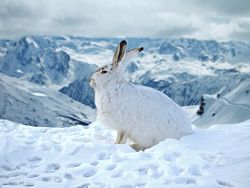

Mountain hares in Scotland are failing to adapt to climate change, leaving them more vulnerable to predators.
As snow begins to fall mountain hares camouflage themselves by shedding their dark fur to become white. But the mountain hares are failing to adapt to no-snow days, with their white fur on dark mountainsides leaving them visible to potential predators.
Some species have been shown to adapt their moult times to the rapidly changing climate, but mountain hares are not changing their moult at all, leaving them lacking appropriate camouflage on an extra 35 days each year on average, compared with 65 years ago.
Historical records of mountain hare moults in the 1950s were compared with an observation of hares at comparable Scottish sites in 2015 and 2016 by a team of scientists in North America and Scotland.
The researchers also analysed more than six decades of weather data revealing a drastic decline in snow days over a similar period. They found there was an average decline of 37.14 days of annual snow cover between 1960 and 2016 on their Highland study sites. By 2016, the average early autumn snows occurred four days later while the late spring snows were on average a week earlier than in the 1960s.
According to the scientists, the failure of the hares to adapt their moults when other animals in different environments are doing so could be because of:
Scott Newey, a co-author of the study, said: "The fact that mountain hares are not adapting the moult is really quite surprising. It could be because the mountain hare population doesn’t have the diversity within the gene pool to adapt and make changes, or it could be that the change in snow-lie is too rapid".
"The third hypothesis is that the studies were carried out on areas that are managed for driven grouse shooting and driven grouse shooting is associated with predator control, particularly foxes and crows, which are legally controlled".